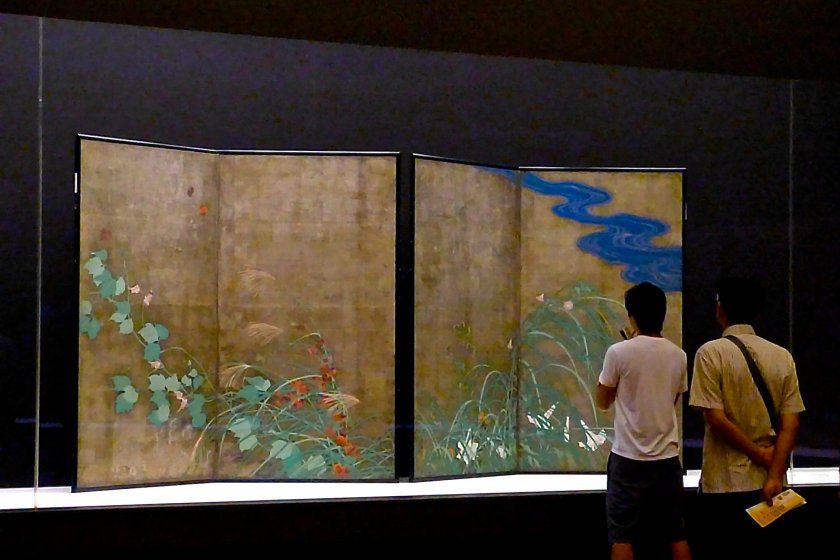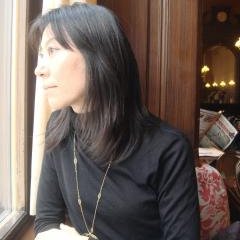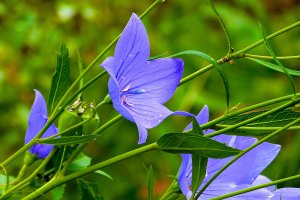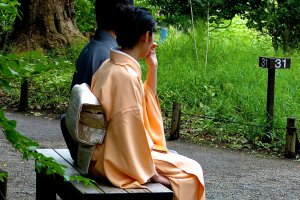People in Edo (old Tokyo) adored flowers. Especially during the time of “Bunka-Bunsei” (1804-1829, in the late Edo Era), a lot of flower fairs and shows were held here and there. Mukojima Hyakka-en Gardens were one way Edoites expressed their strong affection for flowers. An antique dealer appealed to rich cultured friends and built the garden in cooperation with them. The man who named the garden, and one of the collaborators and patrons of the garden, was a leading artist of the Edo Rimpa School, Hoitsu Sakai. He was born as a high-ranking samurai, but he left home at an early age and lived as a cultured man. Later, he admired Korin Ogata (1658-1716) and painted many pieces that were influenced by him. Although Korin’s works were powerful and gorgeous, Hoitsu opened up his own unique world to express an exquisite delicate sense of beauty for tiny, delicate, pretty plants and flowers.
Mukojima Hyakka-en Gardens
These gardens were built for visitors to enjoy various seasonal flowers. At first, they planted 360 plum blossoms in the wild gardens. And step-by-step, the founder collected hundreds of plants that appeared in pieces of Japanese classic literature, such as Manyo-shu. Hoitsu named these gardens “Hyakka-en” (the garden with hundreds of flowers), because the gardens started with plum blossoms (that are forerunners of spring), but soon the gardens were overflowing with a profusion of many other kinds of flowers as well.
I visited the gardens just after a rain. It was in early autumn. Raindrops were sparkling on the beautiful green leaves and some of the leaves had already changed to their autumn colors. People enjoyed walking through a flower tunnel made up of cute pink flowers of Japanese bush clover. Elegant Chinese bellflowers and noble ginger flowers were also at their very best. These dainty little flowers were quite popular among the people of Edo, and even now, we love them very much.
Hoitsu Sakai (1761-1828)
Hoitsu Sakai was born in 1761, the second son of a daimyo in Himeji. His grandfather was a roju (an official of the highest rank in the Tokugawa Shogunate). His parents died when the children were still young, and his brother inherited the estate under the guardianship of their grandfather. When Hoitsu was 30, he left home and became a priest so that his brother’s son would be able to take over the position of family leader. In this case, becoming a priest was just a matter of form. By doing so, Hoitsu was declaring his intentions not to inherit the family fortune.
Around 1790, Hoitsu started to compose haiku poem manuscripts and paint pictures in earnest. Both his poems and pictures worked in unison to express his artistic mind. For his paintings, he studied and learned from the great pieces of Korin that had been handed down in the Sakai Family. The Sakais were patrons of Korin during his stay in Edo. Hoitsu lived about 100 years after Korin, but for Hoitsu, Korin was his great instructor in art.
In 1821, Hoitsu produced the best work of his life, “Flowering Plants of Summer and Autumn” (Natsuakikusa-zu Byobu). Based on a request from the father (Harusada Hitotsubashi) of the Shogun, Hoitsu painted this picture on the reverse side of a famous Korin golden folding screen, “The Wind and Thunder Gods” (Fujin Raijin Zu), which was itself a copy of Sotatsu's original of the same title from 1639. It was a big chance for Hoitsu: He would challenge himself to match the genius of Korin on the same folding screen. Take a look here to see how Hoitsu did. What do you think?
“Flowering Plants of Summer and Autumn”
The right-side panel implies a gentle shower in the late summer. Pink bindweed and white lilies are standing with their heads drooping. A river has been swelling little by little. On the other hand, at the left-side panel, the rain has stopped. Fluttering red leaves of Japanese arrowroot and the bending grass of Japanese pampas make us feel a strong autumn wind. This screen represents a seasonal change from summer to autumn.
As I mentioned above, this screen has a double structure. At the reverse side of Hoitsu’s late summer is Korin’s Wind God, and at the back of Hoitsu’s autumn is Korin’s Thunder God. It means that the plants are shaking in the wind from the Wind God, and the flowers are getting wet in the rain that the Thunder God makes. The Wind and Thunder Gods are in the sky and they rise above the world. Korin depicted a world beyond human knowledge. So, Hoitsu expressed the earthly world where he felt time passing, flowers blooming, weather changing, and the seasons and life continuing. Since the background of Korin’s panel is a bold gold, Hoitsu used a quiet silver on his panel. Perhaps it shows the delicate and quiet state that he reached in his life.
These pictures are now separated into two screens for the sake of preservation. Hoitsu’s painting is usually exhibited for only two weeks in autumn. Please check the schedule here.
- 13-9 Uenokoen, Taito City, Tokyo 110-8712
- 9:30 - 17:00 (Closed now)
- ¥620



































